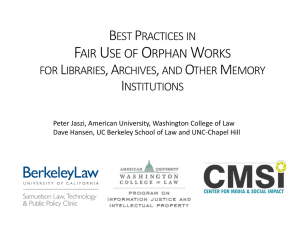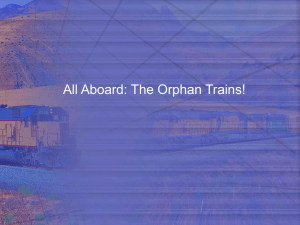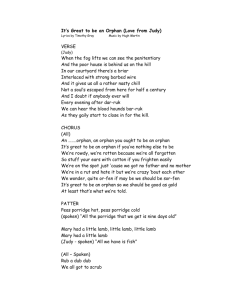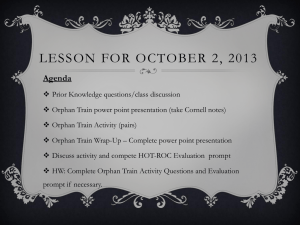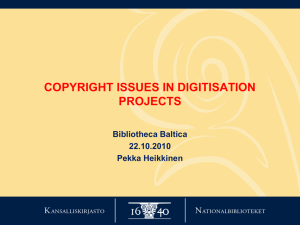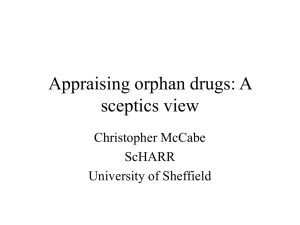orphan_works_submission_121126
advertisement
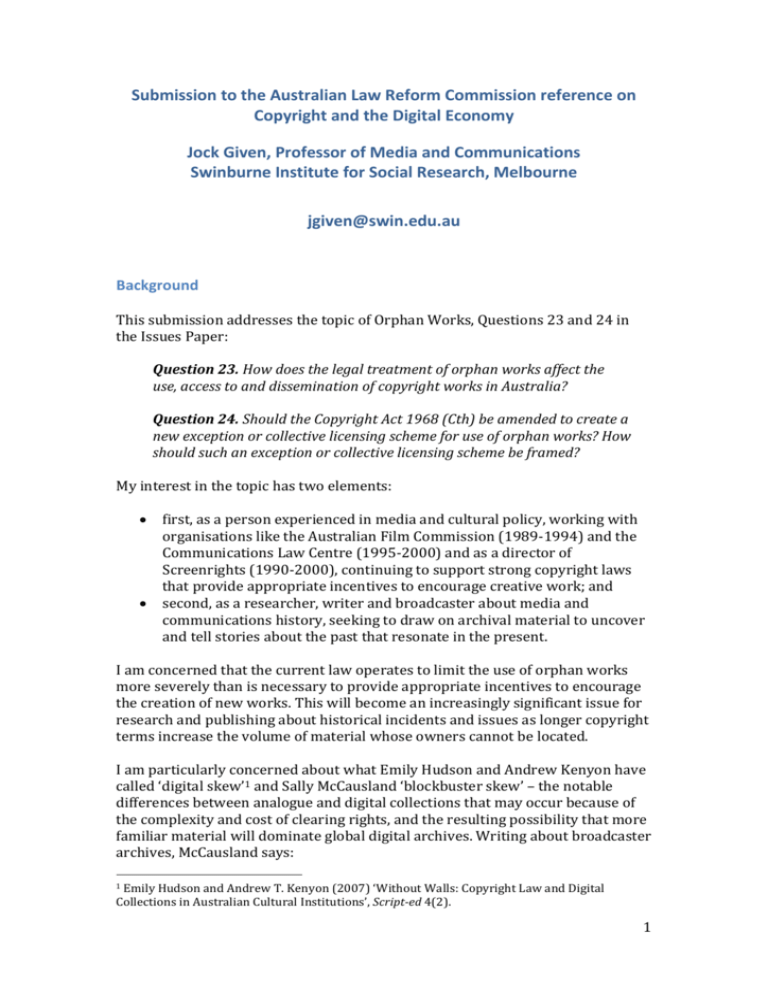
Submission to the Australian Law Reform Commission reference on Copyright and the Digital Economy Jock Given, Professor of Media and Communications Swinburne Institute for Social Research, Melbourne jgiven@swin.edu.au Background This submission addresses the topic of Orphan Works, Questions 23 and 24 in the Issues Paper: Question 23. How does the legal treatment of orphan works affect the use, access to and dissemination of copyright works in Australia? Question 24. Should the Copyright Act 1968 (Cth) be amended to create a new exception or collective licensing scheme for use of orphan works? How should such an exception or collective licensing scheme be framed? My interest in the topic has two elements: first, as a person experienced in media and cultural policy, working with organisations like the Australian Film Commission (1989-1994) and the Communications Law Centre (1995-2000) and as a director of Screenrights (1990-2000), continuing to support strong copyright laws that provide appropriate incentives to encourage creative work; and second, as a researcher, writer and broadcaster about media and communications history, seeking to draw on archival material to uncover and tell stories about the past that resonate in the present. I am concerned that the current law operates to limit the use of orphan works more severely than is necessary to provide appropriate incentives to encourage the creation of new works. This will become an increasingly significant issue for research and publishing about historical incidents and issues as longer copyright terms increase the volume of material whose owners cannot be located. I am particularly concerned about what Emily Hudson and Andrew Kenyon have called ‘digital skew’1 and Sally McCausland ‘blockbuster skew’ – the notable differences between analogue and digital collections that may occur because of the complexity and cost of clearing rights, and the resulting possibility that more familiar material will dominate global digital archives. Writing about broadcaster archives, McCausland says: Emily Hudson and Andrew T. Kenyon (2007) ‘Without Walls: Copyright Law and Digital Collections in Australian Cultural Institutions’, Script-ed 4(2). 1 1 The sense of history which comes with access to the whole, or a substantial part, of an archive, is of much greater cultural value than a small selection curated through the random prism of copyright clearance. … There is a danger that in the digital age the publicly available cultural history of broadcasting will skew: we will remain familiar with ubiquitous blockbuster programs which are available everywhere more than we will remember local Australian programs left in the archives.2 On the other hand, the complexity of rights-holding alone is not a sufficient reason to completely undermine rights granted to all creators at any time, in favour of open, unremunerated access to an unrestricted class of users. Law changes made to support mass digitization projects need to provide the right base for creativity in the distant future, not just a convenient tool for easier access to already-existing material in the present. Broadly I support a statutory licence along the lines proposed in National and State Libraries Australasia’s ‘Position statement on reasonable search for orphan works’, but believe any scheme should be limited to works older than a certain age. The scheme would require a diligent search and the payment of equitable remuneration if rights-holders come forward. With these safeguards, I think the scheme could be fairly flexible about the uses and users of qualifying orphan works. Examples Assembling materials for a radio documentary broadcast on ABC Radio National early in 2012, I sought permission to include images to post on the program website. Pre-1955 photographs could be used because copyright had expired. Other images comprised artistic works from the 1920s-1940s, including: a drawing from the cover of an invitation to an event organised by a communications company to launch a new service in 1927. The artist was not identified. It seemed likely that the company had acquired the right to publish the image on the invitation and perhaps other re-use rights under a contract of employment or a licensing agreement. The company’s current staff were happy to approve the use of the image but without evidence of any agreement with the artist, it was not clear that it was the company’s approval that was needed; cartoons published in newspapers in the 1930s and 40s. The artists were identified but the library where the originals were held was not able to track the current rights-holders. The newspapers may have acquired reuse rights, perhaps under contracts of employment or licensing 2 S. McCausland (2009), ‘Getting public broadcaster archives online: orphan works and other copyright challenges of clearing old (but in copyright) cultural material for digital use’, Media and Arts Law Review, 14. 2 agreements, but without evidence of any agreement with the artist, it was not clear whose approval was needed. I would have been happy to pay a licensing fee to rights-holders, if they were able to be located and the works were still in copyright. In the circumstances, however, the library holding the material felt unable to authorize their reuse on the ABC’s program website and we did not use them. This was quite understandable, given the legal position, but, it did not seem to serve anyone’s interests. It meant the works are only available to those who can physically visit the library; people with a direct interest in the story don’t see it told to best effect; and the artists or their representatives, 70-85 years after the creation of the works, get no payment or exposure and hence no incentive to create further works in the future. These are very small, personal examples of what seems likely to be a growing challenge with longer copyright terms, even for works that probably only have a single rights-holder. For collaborative works with more complex rights-holding, the situation can be much more complex. Issues I believe it should be possible to craft a scheme for orphan works that: is consistent with the ‘three-step test’ of international copyright law; and meets the goals of balancing ‘user accountability, predictive certainty for users and fairness to rights holders’, set out in the paper by Brennan and Fraser cited in the Issues Paper.3 Several issues seem relevant to such a scheme: the age of the materials covered; the uses made of them; the nature of the users; the things a user might be required to do to avail themselves of the scheme, including: o undertaking a diligent search for rights-holders; o paying remuneration to rights-holders who come forward after publication or to a fund in anticipation of future claims; o attributing rights-holders. Age National and State Libraries Australasia notes in its ‘Position statement on reasonable search for orphan works’ that orphan works are often thought of as 3 D Brennan and M Fraser (2012), The Use of Subject Matter with Missing Owners - Australian Copyright Policy Options. 3 older works, but ‘can also be anonymous works on the internet, poorly credited works, abandoned materials, and works where the copyright owner is unaware they own copyright’. This is true, but the justification for extending some form of special treatment to orphan works increases with their age for at least two reasons. First, the older a work, the more time rights-holders have had to profit from their rights, thus deriving the incentive to create more works which is copyright’s purpose. This is directly relevant to the first two steps of the three-step test: that the use must not conflict with the normal exploitation of the work by the copyright holder; and must not unreasonably prejudice the copyright holder. A statutory licence authorizing use of orphan works without the express permission of the rightsholders is less likely to conflict with normal exploitation or to unreasonably prejudice the copyright holder if it only applies to older works. Second, the older a work, the more difficult it is to trace the rights-holder. So as a work ages, the balance between revenue and cost for creator and user shifts. Potential revenue for the creator generally declines; the likely cost for the user of tracing rights-holders increases. This suggests that an orphan works scheme could be limited to works created, published or deposited in an archive at least a prescribed number of years ago. The period might be set, cautiously, at 50 years; or, more expansively, at the ‘open access period’ prescribed in the Archives Act 1983. This is being progressively reduced from 30 to 21 years.4 Limiting the scheme to works beyond a certain age would reduce the need for additional safeguards about the uses and users allowed. Uses Any use of orphan works authorised by the scheme should be non-exclusive. Beyond this, it is difficult to restrict the types of uses authorised by the scheme without significantly undermining the benefit from such a scheme in the first place. In particular, limiting it to ‘non-commercial’ use may prevent material incorporating parts of the works from being included in a commerciallypublished book or posted on video-sharing sites like YouTube, blogs or social networking sites, where advertising revenues are earned by site operators although many individual users are not motivated by profit. Users Some have suggested that only particular types of users should be able to use material under an orphan works scheme, such as ‘natural persons’ or public institutions like archives or national broadcasters. 4 Section 3(7). 4 These suggestions seem unduly restrictive. A scheme applying only to natural persons would exclude major public institutions who seem well-placed to make innovative use of their own archives. But a scheme applying only to them would not assist the productive exploration and use of hard-to-find materials that seem likely to be made by individuals with highly specialized interests and skills. Pre-requisites and process Diligent search: Users should be required to undertake a ‘diligent search’ before concluding that a work is an orphan work covered by the statutory licence. The ‘Standards for a reasonable search’ set out in the National and State Libraries Australasia’s ‘Position statement on reasonable search for orphan works’ seem a good guide, although I prefer the term ‘diligent search’ to ‘reasonable search’. These standards describe ‘a continuum of effort ranging from minimal through to an extensive or extraordinary search’. In particular, the effort required should be greater where the work is recent, or created for professional purposes or proposed to be used in ways that are hard to revoke. Equitable remuneration: Rights-holders who come forward within a reasonable time after the re-use of works that qualified as orphan works should be able to claim equitable remuneration from the user. Users should not be required to pay fees in anticipation of claims that might never be made. This increases the costs of use without necessarily providing any incentive for those who created the works used to produce new works. Attribution: The status of orphan works should be appropriately identified when they are re-used. Known but untraceable rights-holders should be appropriately acknowledged. Process: Users should not be required to undertake procedures beyond the diligent search: for example, to issue a notice of intent to use a work. No formal orphan works register should be established, but libraries and archives should – as many do now – include information about the copyright status of works in their catalogue records, including information about any ‘diligent search’ already conducted. Jock Given Swinburne Institute for Social Research Hawthorn, Victoria 26 November 2012 5

